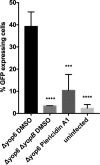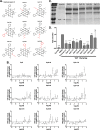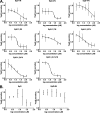Synthetic Cyclic Peptomers as Type III Secretion System Inhibitors
- PMID: 28652236
- PMCID: PMC5571333
- DOI: 10.1128/AAC.00060-17
Synthetic Cyclic Peptomers as Type III Secretion System Inhibitors
Abstract
Antibiotic-resistant bacteria are an emerging threat to global public health. New classes of antibiotics and tools for antimicrobial discovery are urgently needed. Type III secretion systems (T3SS), which are required by dozens of Gram-negative bacteria for virulence but largely absent from nonpathogenic bacteria, are promising virulence blocker targets. The ability of mammalian cells to recognize the presence of a functional T3SS and trigger NF-κB activation provides a rapid and sensitive method for identifying chemical inhibitors of T3SS activity. In this study, we generated a HEK293 stable cell line expressing green fluorescent protein (GFP) driven by a promoter containing NF-κB enhancer elements to serve as a readout of T3SS function. We identified a family of synthetic cyclic peptide-peptoid hybrid molecules (peptomers) that exhibited dose-dependent inhibition of T3SS effector secretion in Yersinia pseudotuberculosis and Pseudomonas aeruginosa without affecting bacterial growth or motility. Among these inhibitors, EpD-3'N, EpD-1,2N, EpD-1,3'N, EpD-1,2,3'N, and EpD-1,2,4'N exhibited strong inhibitory effects on translocation of the Yersinia YopM effector protein into mammalian cells (>40% translocation inhibition at 7.5 μM) and showed no toxicity to mammalian cells at 240 μM. In addition, EpD-3'N and EpD-1,2,4'N reduced the rounding of HeLa cells caused by the activity of Yersinia effector proteins that target the actin cytoskeleton. In summary, we have discovered a family of novel cyclic peptomers that inhibit the injectisome T3SS but not the flagellar T3SS.
Keywords: Pseudomonas aeruginosa; T3SS; Yersinia; cyclic peptides; peptoids; peptomers; type III secretion system; virulence blocker.
Copyright © 2017 American Society for Microbiology.
Figures









Similar articles
-
Fitting Pieces into the Puzzle of Pseudomonas aeruginosa Type III Secretion System Gene Expression.J Bacteriol. 2019 Jun 10;201(13):e00209-19. doi: 10.1128/JB.00209-19. Print 2019 Jul 1. J Bacteriol. 2019. PMID: 31010903 Free PMC article. Review.
-
Developing Cyclic Peptomers as Broad-Spectrum Type III Secretion System Inhibitors in Gram-Negative Bacteria.Antimicrob Agents Chemother. 2021 Jun 17;65(7):e0169020. doi: 10.1128/AAC.01690-20. Epub 2021 Jun 17. Antimicrob Agents Chemother. 2021. PMID: 33875435 Free PMC article.
-
An NF-κB-based high-throughput screen identifies piericidins as inhibitors of the Yersinia pseudotuberculosis type III secretion system.Antimicrob Agents Chemother. 2014;58(2):1118-26. doi: 10.1128/AAC.02025-13. Epub 2013 Dec 2. Antimicrob Agents Chemother. 2014. PMID: 24295981 Free PMC article.
-
Exploring resveratrol dimers as virulence blocking agents - Attenuation of type III secretion in Yersinia pseudotuberculosis and Pseudomonas aeruginosa.Sci Rep. 2020 Feb 7;10(1):2103. doi: 10.1038/s41598-020-58872-0. Sci Rep. 2020. PMID: 32034212 Free PMC article.
-
Targeting the Type Three Secretion System in Pseudomonas aeruginosa.Trends Pharmacol Sci. 2016 Sep;37(9):734-749. doi: 10.1016/j.tips.2016.05.011. Epub 2016 Jun 22. Trends Pharmacol Sci. 2016. PMID: 27344210 Review.
Cited by
-
Peptidomimetics as Potential Anti-Virulence Drugs Against Resistant Bacterial Pathogens.Front Microbiol. 2022 Apr 18;13:831037. doi: 10.3389/fmicb.2022.831037. eCollection 2022. Front Microbiol. 2022. PMID: 35516442 Free PMC article. Review.
-
Promises and Challenges of the Type Three Secretion System Injectisome as an Antivirulence Target.EcoSal Plus. 2019 Feb;8(2):10.1128/ecosalplus.ESP-0032-2018. doi: 10.1128/ecosalplus.ESP-0032-2018. EcoSal Plus. 2019. PMID: 30706846 Free PMC article. Review.
-
Secretory System Components as Potential Prophylactic Targets for Bacterial Pathogens.Biomolecules. 2021 Jun 15;11(6):892. doi: 10.3390/biom11060892. Biomolecules. 2021. PMID: 34203937 Free PMC article. Review.
-
Fitting Pieces into the Puzzle of Pseudomonas aeruginosa Type III Secretion System Gene Expression.J Bacteriol. 2019 Jun 10;201(13):e00209-19. doi: 10.1128/JB.00209-19. Print 2019 Jul 1. J Bacteriol. 2019. PMID: 31010903 Free PMC article. Review.
-
1,2,3-Triazoles as Biomimetics in Peptide Science.Molecules. 2021 May 14;26(10):2937. doi: 10.3390/molecules26102937. Molecules. 2021. PMID: 34069302 Free PMC article. Review.
References
MeSH terms
Substances
Grants and funding
LinkOut - more resources
Full Text Sources
Other Literature Sources
Medical

